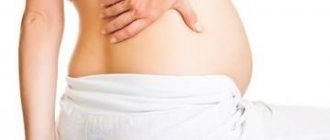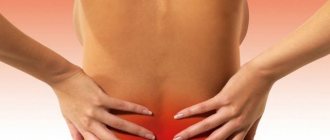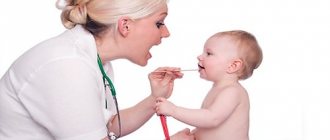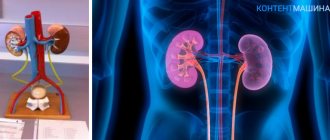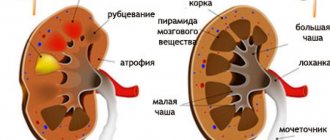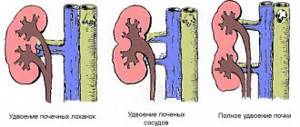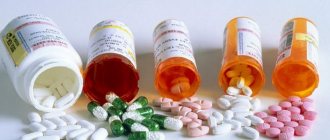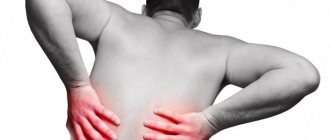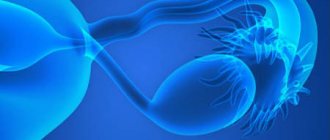Home Genitourinary diseases Symptoms of genitourinary diseases
- How can pathology be determined?
- Why does the left kidney hurt - reasons
- Referring pain
- Pain in the left kidney - what to do
Pain that occurs in the kidneys is not always associated with them. Often the source of the disease is some other pathology, so it is important to find out the real cause. This article highlights the main diseases that cause kidney pain on the left side, symptoms, treatment and diagnostic methods.
For what reasons can the left kidney hurt?
Referring pain in the kidney on the left is a common symptom that occurs in children and adults. However, you should not immediately panic when you feel pain on the left, since this sign does not always indicate the presence of a pathological process.
Pain in the left kidney can also occur after physical overload, this especially applies to men who are more susceptible to heavy physical activity.
As for kidney diseases, which can be expressed by pain in the organ on the left, these include:
- nephroptosis – prolapse of the kidney;
- a cyst in the left kidney; as it enlarges, it begins to compress the ureter, which causes pain in the left kidney;
- pyelonephritis – inflammation of the renal pelvis;
- urolithiasis, which causes severe pain in the lower back;
- kidney cancer, which, as a rule, manifests itself as pain in the later stages.
In addition, the cause of pain localized in the kidney on the left may be congenital abnormalities associated with the formation and development of the organ. Congenital stenosis, for example, can be difficult to diagnose even for experienced specialists.
Triplication of parts of the kidney is also a difficult to diagnose pathology, which is often expressed by pain in the left kidney.
Sharp pain can also occur due to a fall, a strong blow, or rupture of an organ. In this case, the pain does not go away on its own.
Renal artery stenosis
Prevention
Pain in the kidneys can be eliminated through prevention. Doctors have found that discomfort often occurs with poor nutrition and drinking alcohol.
In this case, you need to give up alcohol and adjust your diet. Be sure to use the correct treatment, in the regimen prescribed by the doctor. Do not use foods and drinks that burden the functioning of the paired organ.
In the cold season, you need to cover your lower back to prevent hypothermia. Be sure to monitor the drinking regime, hygiene of the genitals and hands, which will prevent infection with pathogenic bacteria.
You need to engage in an active lifestyle, but not overload the body, then your health will be normal and your kidneys will not be disturbed. For chronic diseases, preventive measures exclude relapses and exacerbations.
Pain in the left kidney that is not associated with renal pathologies
In some cases, it turns out that pain concentrated on the left has nothing to do with nephrological pathologies. In this case, the pain is associated with other organs, so it is important to pay special attention to whether there are other warning signs.
Often the left kidney may hurt due to the following abnormalities:
- Inflammation of organs located in the pelvis. Painful sensations in this case can also be concentrated in the ovaries.
- Ulcer of the duodenum or stomach.
- Inflammation of the pancreas. At the same time, undigested food in the feces is added to the pain in the lower back.
- Gallstone pathologies, which have a feature expressed by a stabbing sensation in the gallbladder and yellowness of the skin.
- An aortic aneurysm is an enlargement of a blood vessel that can cause pain in the kidney. It is important to note that this pathology poses a great danger to life.
The causes of pain in the left kidney can also be osteochondrosis or radiculitis. In the latter case, inflammation of the nerve roots occurs, intense pain appears, radiating to the lower back.
That is why radiculitis is often mistaken for renal abnormalities and only during the diagnostic process is the correct diagnosis made.
As for osteochondrosis, this condition can be expressed by aching pain in the legs and both kidneys. In this case, the sensitivity of the limbs is impaired.
Preventive measures
Prevention of discomfort in the area of the left kidney is aimed at strengthening the body and stimulating kidney function. To do this, it is recommended to limit the consumption of alcohol-containing drinks, reduce the consumption of spicy, salty and fried foods, try not to overcool the body and be careful about personal hygiene.
There are many reasons for the appearance of discomfort in the area of the left kidney: from banal overwork to a developing cancerous tumor. Therefore, it is important to diagnose the body in a timely manner in order to exclude serious pathologies.
Painful sensations in women and men indicate dysfunction of many organs, not just the kidney. But in any case, this problem should not be ignored.
In the presence of a concomitant disease, symptoms and treatment when the kidney hurts on the left side differ significantly. Therefore, a thorough diagnosis is necessary so that adequate treatment can be prescribed.
How to understand that pain in the lower back on the left is associated specifically with the kidney?
For kidney pathologies, in addition to lower back pain, other symptoms are also characteristic. According to medical statistics, only 5% of patients complaining of lower back pain on the left have kidney pathologies.
In other cases, pain occurs due to damage to other organs that radiate to the lower back. If the kidney on the left hurts, then the following symptoms are added to the pain:
- impaired urination, which may become more frequent or, conversely, become less frequent;
- frequent urge to urinate, while urine is released in minimal quantities;
- cloudy urine, presence of sand and stones in it;
- blood in the urine;
- intense burning pain at the end of urination;
- itching of the skin.
Symptoms are supplemented depending on what disease we are talking about. Pyelonephritis, for example, among other things, is accompanied by swelling, and aching pain in the kidney is constantly present.
But with nephroptosis, when taking a lying position, the intensity of pain decreases. Hydronephrosis is characterized by increased blood pressure and swelling of the extremities. A feeling of heaviness in the back and abdomen is accompanied by the formation of a cyst.
Diagnostics
In order to make an accurate diagnosis and identify the root cause of the development of pain, a person is recommended to consult a urologist. At the stage of medical examination, the patient is examined and the kidney projection area is palpated. More detailed diagnostics include the following examination methods:
- General clinical urine analysis, bacteriological examination of urine, Zimnitsky and Nechiporenko tests. These laboratory testing options are prescribed to detect inflammatory diseases, as well as to assess the dynamics of urine excretion.
- General clinical and biochemical blood test.
- Ultrasound examination of the kidneys, which makes it possible to detect structural changes in the paired organ, stones, sand, dilation of the pelvis and calyces, benign and malignant neoplasms.
- Magnetic resonance imaging, which makes it possible to examine layer-by-layer sections of the kidney and detect any changes in its structure.
- Renal biopsy. This technique is used for the purpose of histological examination of the detected tumor to identify atypical cells.
Diagnostic measures
It is possible to establish the exact reason why the left kidney hurts only after visiting a doctor and undergoing the necessary examination. Initially, the doctor finds out what symptoms are bothering the patient and the time of their onset. Then, without fail, the patient donates blood and urine for a general analysis, which will determine protein and an increased concentration of leukocytes.
Donating blood for biochemical analysis is also an important diagnostic method that determines the level of creatine, calcium, magnesium and other substances in the body. In addition, to make an accurate diagnosis, the following instrumental studies are prescribed:
- Ultrasound of the kidneys and abdominal organs;
- X-ray examination of the spine;
- kidney urography;
- angiography, which allows using a contrast agent to determine the condition of the vessels;
- a biopsy of the affected kidney, with the help of which a microscopic analysis of the affected tissue is performed and the etiology of the disease is established.
It is important to note that if the pain in the kidney is persistent, such a symptom cannot be ignored, since, most likely, we are talking about a chronic disease.
All of the above diagnostic methods will help to establish the exact cause of the unpleasant symptoms, after which the patient will be prescribed the correct and competent treatment. However, if other pathological processes are suspected, the doctor may prescribe additional diagnostic measures.
Why is this happening and what to do?
To begin with, you should understand why only one kidney can hurt, and not both at once. Of course, this is a paired organ, but inflammation or a pathological process does not always develop synchronously. Partly, this is how nature intended it so that a person could cure an illness in time without harm to health.
In addition, it is not only a paired organ, but also a vital organ. A serious illness and the need to remove one kidney will lead to disability, but in general, it will not cause any special problems for a person.
But a disease of two kidneys at once can lead to death or the need for transplantation, which is not always possible urgently.
There may be several causes of pain in the kidney, here are just a few of them:
- the presence of sand or stones in only one kidney, or the movement of a stone in the direction where the pain is localized;
- malignant formation, cyst or benign tumor in or near the diseased kidney;
- blockage of the passages of the organ and, as a result, its inflammation;
- significant hypothermia of one side, which preceded the onset of pain, and much more.
There are a lot of reasons why the kidney on the left side hurts, and in order to accurately find out the origin of the unilateral pain, find out whether it’s really the kidneys hurting or whether some neighboring organ is “indignant”, and also choose the right treatment regimen, you must definitely visit a doctor .
You should not self-medicate at home, without an accurately established diagnosis.
All actions for the treatment of kidney diseases, and especially drug treatment, must be strictly coordinated with the doctor.
Unskilled treatment and improper use of medications, and even more so their abuse, can lead to such serious consequences as:
- kidney rupture - one or two at once in severe cases;
- blockage of the ducts, which requires urgent surgical intervention;
- cyst formation;
- the need for organ removal and subsequent transplantation;
- degeneration of a benign tumor into a malignant one;
- the need for surgery and subsequent hemodialysis and much more.
At the first symptoms of the disease, be it the kidneys or something very similar in symptoms, you need to urgently visit a doctor, take the required tests and carry out the necessary treatment.
How to quickly relieve pain?
With acute kidney pain, a person wants to quickly get rid of the disturbing symptom. If there is severe pain in the left kidney, what should you do to eliminate it as quickly as possible? After all, first a person wants to get rid of an exhausting symptom, and then find out the reason for its appearance.
Most often, the cause of spasms is an inflammatory process. Antispasmodics and analgesics will help to cope with it. If, after taking them, the pain does not decrease, and even more so if it worsens, you should immediately seek medical help.
In this case, doctors will administer antispasmodics to the patient intramuscularly or intravenously, which will alleviate his condition until the cause of the spasms is determined.
Painful sensations in the left kidney can occur due to poor nutrition. In this case, the patient must adhere to a special diet, which consists of limiting everything spicy, smoked and salty.
What absolutely cannot be done?
“My left kidney hurts – what should I do?” - the most frequently asked question. Moreover, it is asked not in the doctor’s office, but in an Internet search engine. And this is very wrong. Because there is a lot of advice on the Internet, but they are of little use.
Self-medication can only make the problem worse
Advice that can be found on the Internet based on this request will not always allow you to quickly improve your health and stop the onset of a serious illness, but on the contrary, they can threaten serious complications of even the mildest ailment.
What absolutely cannot be done when a kidney hurts on one side or the other, or both sides at once:
- You should not start taking antibiotics without a doctor’s prescription;
- you should not get too cold and walk in the wind with your lower back exposed;
- It is not recommended to take a contrast shower;
- in addition, you should not sleep in a draft, or even be in it;
- You should not drink too much water or eat highly salty foods. It is generally better to limit the amount of salt so as not to create additional stress on the organ;
- there is no need to rub the lower back with warming ointments, as this can accelerate the development of the disease;
- Everyone experiences pain for different reasons - you cannot be treated with the same thing that helped a relative or friend;
- There is no need to take long hot baths, especially if there is unclear discharge, fever or chills.
As you can see, when the kidney hurts on the left side, the symptoms and treatment can be very different.
Only a competent specialist will be able to find the source of your poor health, as well as prescribe treatment that will definitely not harm your health.
Treatment methods
After establishing an accurate diagnosis, the doctor develops a treatment regimen that will eliminate lower back pain on the left and other unpleasant symptoms. Depending on the stage and nature of the pathology, the patient can be treated at home or in a hospital.
In most cases, renal pathology is treated with medication. In case of a serious pathological process, the patient is hospitalized for competent treatment under strict medical supervision.
With nephroptosis, the patient must wear a special bandage to help hold the kidney in place.
Antibacterial drugs are used to treat pyelonephritis. Complex conservative therapy also includes vitamin complexes that enhance immunity. Conservative treatment must be supplemented with an appropriate diet and therapeutic exercises.
Surgical treatment
If a patient is diagnosed with an increasing cyst or malignant tumor, in this case the only effective treatment is surgery. It can be carried out in several ways, it all depends on the degree of damage and the size of the tumor.
In modern medicine, percutaneous puncture is successfully used, which involves calcining the cyst and installing drainage. However, this method cannot be called safe, since the risk of kidney infection during the procedure remains high.
The safest and most popular method is laparoscopic surgery. Through small incisions, the surgeon inserts an endoscope and the necessary instruments into the lesion. This method allows you to remove the formation and shorten the rehabilitation period for the patient.
Abdominal surgery is the most difficult method of treating renal pathology, consisting of an incision in the abdominal cavity. This method is used for malignant formations or modifications of the cyst. A malignant tumor is treated by open surgery and conservative treatment after it, which consists of chemotherapy, hormonal, radiation and immune therapy.
